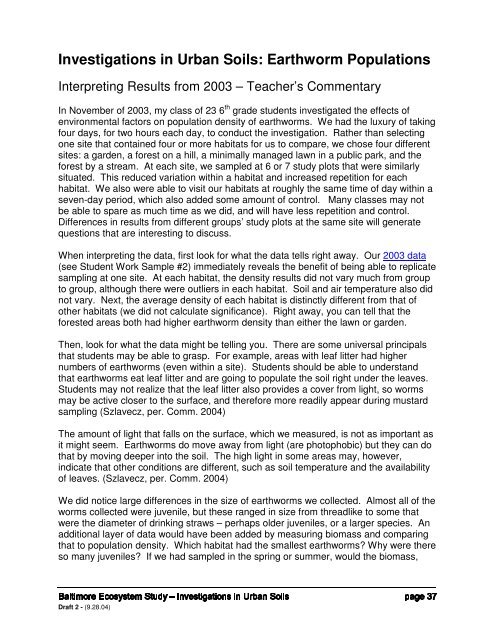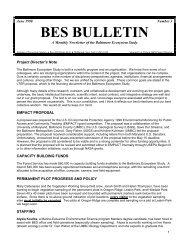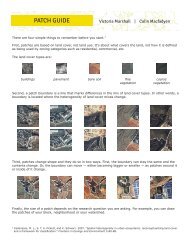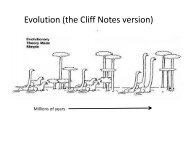Investigations in Urban Soils - Baltimore Ecosystem Study
Investigations in Urban Soils - Baltimore Ecosystem Study
Investigations in Urban Soils - Baltimore Ecosystem Study
Create successful ePaper yourself
Turn your PDF publications into a flip-book with our unique Google optimized e-Paper software.
<strong>Investigations</strong> <strong>in</strong> <strong>Urban</strong> <strong>Soils</strong>: Earthworm Populations<br />
Interpret<strong>in</strong>g Results from 2003 – Teacher’s Commentary<br />
In November of 2003, my class of 23 6 th grade students <strong>in</strong>vestigated the effects of<br />
environmental factors on population density of earthworms. We had the luxury of tak<strong>in</strong>g<br />
four days, for two hours each day, to conduct the <strong>in</strong>vestigation. Rather than select<strong>in</strong>g<br />
one site that conta<strong>in</strong>ed four or more habitats for us to compare, we chose four different<br />
sites: a garden, a forest on a hill, a m<strong>in</strong>imally managed lawn <strong>in</strong> a public park, and the<br />
forest by a stream. At each site, we sampled at 6 or 7 study plots that were similarly<br />
situated. This reduced variation with<strong>in</strong> a habitat and <strong>in</strong>creased repetition for each<br />
habitat. We also were able to visit our habitats at roughly the same time of day with<strong>in</strong> a<br />
seven-day period, which also added some amount of control. Many classes may not<br />
be able to spare as much time as we did, and will have less repetition and control.<br />
Differences <strong>in</strong> results from different groups’ study plots at the same site will generate<br />
questions that are <strong>in</strong>terest<strong>in</strong>g to discuss.<br />
When <strong>in</strong>terpret<strong>in</strong>g the data, first look for what the data tells right away. Our 2003 data<br />
(see Student Work Sample #2) immediately reveals the benefit of be<strong>in</strong>g able to replicate<br />
sampl<strong>in</strong>g at one site. At each habitat, the density results did not vary much from group<br />
to group, although there were outliers <strong>in</strong> each habitat. Soil and air temperature also did<br />
not vary. Next, the average density of each habitat is dist<strong>in</strong>ctly different from that of<br />
other habitats (we did not calculate significance). Right away, you can tell that the<br />
forested areas both had higher earthworm density than either the lawn or garden.<br />
Then, look for what the data might be tell<strong>in</strong>g you. There are some universal pr<strong>in</strong>cipals<br />
that students may be able to grasp. For example, areas with leaf litter had higher<br />
numbers of earthworms (even with<strong>in</strong> a site). Students should be able to understand<br />
that earthworms eat leaf litter and are go<strong>in</strong>g to populate the soil right under the leaves.<br />
Students may not realize that the leaf litter also provides a cover from light, so worms<br />
may be active closer to the surface, and therefore more readily appear dur<strong>in</strong>g mustard<br />
sampl<strong>in</strong>g (Szlavecz, per. Comm. 2004)<br />
The amount of light that falls on the surface, which we measured, is not as important as<br />
it might seem. Earthworms do move away from light (are photophobic) but they can do<br />
that by mov<strong>in</strong>g deeper <strong>in</strong>to the soil. The high light <strong>in</strong> some areas may, however,<br />
<strong>in</strong>dicate that other conditions are different, such as soil temperature and the availability<br />
of leaves. (Szlavecz, per. Comm. 2004)<br />
We did notice large differences <strong>in</strong> the size of earthworms we collected. Almost all of the<br />
worms collected were juvenile, but these ranged <strong>in</strong> size from threadlike to some that<br />
were the diameter of dr<strong>in</strong>k<strong>in</strong>g straws – perhaps older juveniles, or a larger species. An<br />
additional layer of data would have been added by measur<strong>in</strong>g biomass and compar<strong>in</strong>g<br />
that to population density. Which habitat had the smallest earthworms? Why were there<br />
so many juveniles? If we had sampled <strong>in</strong> the spr<strong>in</strong>g or summer, would the biomass,<br />
Draft 2 - (9.28.04)<br />
<strong>Baltimore</strong> <strong>Ecosystem</strong> <strong>Study</strong> – <strong>Investigations</strong> <strong>in</strong> <strong>Urban</strong> <strong>Soils</strong><br />
page 37






